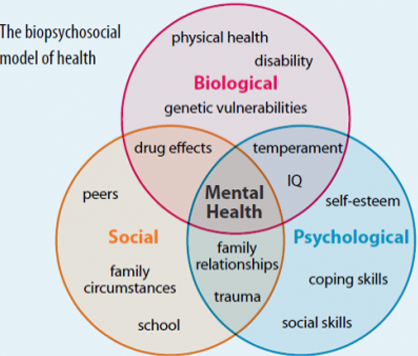Psychological Disorders:
Definition (#f7aeae)
Important (#edcae9)
Extra (#fffe9d)
Key Concepts:
Abnormality.
Psychopathology: Classification and Causes.
Risk Factors.
Psychotic Disorders.
Mood Disorders.
Anxiety Disorders.
Personality Disorders
Abnormality:
Psychopathology: Scientific study of mental, emotional, and behavioral disorders; abnormal or maladaptive behavior.
Statistical Abnormality: Having extreme scores on some dimension, such as intelligence, anxiety, or depression.
Social Nonconformity: Disobeying societal standards for normal and acceptable conduct.
Situational Context: Social situation, behavioral setting, or general circumstances in which an action takes place.
Cultural Relativity: Judgments are made relative to the values of one’s culture.
Subjective Discomfort: Private feelings of pain, unhappiness, or emotional distress.
Maladaptive Behavior:
Behaviour arising from dysfunction which makes it difficult to function, adapt to the environment and to meet everyday demands.
Insanity:
Refers to an inability to manage one’s affairs or foresee the consequences of one’s actions.
More of a legal term.
Those judged insane are not held legally responsible for their actions.
Can be involuntarily committed to a mental hospital.
Established through testimony from expert witnesses.
Not guilty by reason of insanity: The accused, due to a psychological disorder, was unable to realise that what he or she did was wrong.
Classification of Symptoms:
Mental illness is typically diagnosed by establishing the presence or absence of a number of symptoms, assessing duration of symptoms, and extent to which it interfere with life.
Positive Symptoms: Symptoms in excess, or exaggerations of normal behaviour.
Negative Symptoms: Deficiencies or absences compared to normal behaviour.
Comorbidities: Presence of more than 1 disorder at the same time.
General Risk factors:
Risk factors are classified into the biopsychosocial model by George Engel (70s).
Some risks that contribute to psychopathology include:
Biological factors: Organic vs. Environmental.
Psychological factors: Self-esteem, coping skills, personality, stress level, core beliefs, emotional regulation skills.
Social factors: Family system/functionality, socioeconomic status (SES), work/school conditions, peers, loneliness.

Neurodevelopmental vs Neurocognitive Disorders:
Neurodevelopmental Disorders: Nervous system damage that arise prior to adulthood. Ex: Down Syndrome, Autism Spectrum Disorder.
Neurocognitive Disorders: Problems not arising until adulthood. Ex: Parkinson’s disease, or Alzheimer’s disease.
Neurocognitive disorders are often serious mental impairments in old age caused by deterioration of the brain.
Disturbances in memory, reasoning, judgment, impulse control.
Psychotic Disorders:
Psychosis: Loss of contact with shared views of reality.
Hallucinations: Imaginary sensations. Such as seeing, hearing, or smelling things that do not exist in the real world.
Delusions: False beliefs that individuals insist are true, regardless of evidence against it.
Types of delusions:
Depressive
Grandeur
Influence
Persecution
Risk Factors:
Individuals may inherit a potential for developing disorders; they are more vulnerable to its development.
Biochemical Abnormality: Disturbance in brain chemicals or neurotransmitters.
Schizophrenic brain may produce substance similar to a psychedelic.
Overactivity in brain dopamine system or dopamine receptors.
Early Psychological Trauma: Psychological injury or shock, often caused by violence, abuse, or neglect.
Disturbed Family Environment: Stressful or unhealthy family relationships, communication patterns, and emotional atmosphere.
Deviant Communication Patterns: Cause guilt, anxiety, anger and confusion. Ex: double bind communication.
Mood Disorders:
Characterised by major disturbances in emotion.
2 Major Types:
Depressive disorders:
Sadness and despondency are exaggerated, prolonged, or unreasonable.
Symptoms: Low mood, irritability, lack interest, fatigue, worthlessness.
Seasonal Affective Disorder (SAD): Major depressive disorder with seasonal patterns.
Bipolar disorders:
Mania: Period of abnormally excessive energy and elation.
Loud, energetic, require less sleep, hyperactive, grandiosity, invincibility.
Bipolar Disorder Type 1 & 2: Both episodes of depression and mania.
Cyclothymia Disorder: Relatively moderate, but longer lasting form of bipolar disorder.
Suicide:
A diagnosable mental health issue tend to underlie all suicides.
Many other risk factors:
Situational: Events which are intolerable, inescapable.
Personal
Gender: Men succeed more than women, though women carry out more attempts
Marital status: Married individuals have lower suicide rates than divorced, widowed
Anxiety Disorder:
Feelings of apprehension, dread, uneasiness, worry, or fear.
Feelings of distress seem out of proportion, constant worrying, extreme anxiety, panic.
Types:
Generalised Anxiety Disorder (GAD):
At least 6 months
Psychological: Excessive & constant worry.
Physical: Restlessness, fatigue, sleep disturbance, muscle tension.
Panic Disorder:
Presence of panic.
Psychological: Recurrent panic attacks, anxiousness directed towards next panic attack, sense of impending doom.
Physical: Trembling, shaking, fear of dying, chest pain, palpitations, nausea.
Social Anxiety Disorder: Fear or anxiety towards social situations, fear of negative evaluation, avoidance of social situations.
Specific Phobias: Intense irrational fears focused on particular objects or activities.
Personality Disorder:
Long-standing, inflexible ways of behaving that create a variety of problems.
Relates to thinking, feeling and behaving deviates from the expectations of the culture, causes distress or problems functioning, and lasts over time.
Typically begin during adolescence or even childhood.
Types:
Histrionic Personality Disorders:
Constant attention seeking behaviour, through dramatizing their emotions and actions.
Borderline Personality Disorder:
Pattern of instability in personal relationships, intense emotions, violent mood swings, poor self-image and impulsivity.
May go to great lengths to avoid being abandoned.
Antisocial Personality Disorder:
Pattern of disregarding or violating the rights of others.
May not conform to social norms, may repeatedly lie or deceive others, or may act impulsively, lacks conscience.